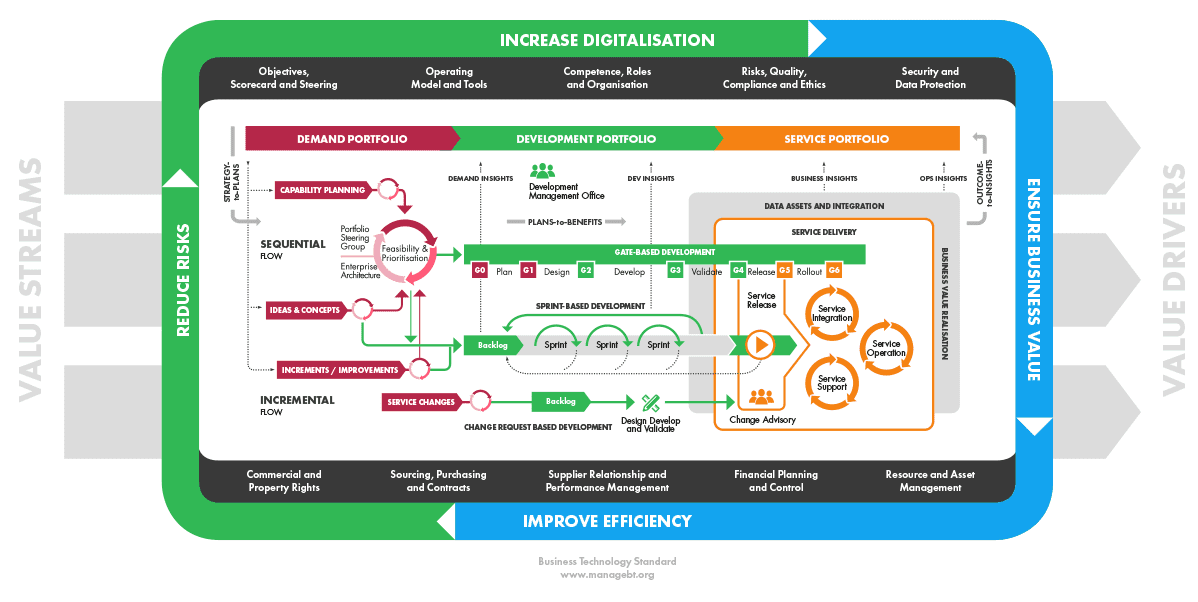Enterprise architecture defines the business capabilities that are required to achieve an organisation’s long-term strategic goals. It is about ensuring good fit for business imperatives by defining the process, data solution layers and the ”must wins” in a continuously evolving market. Changes such as mergers and acquisitions, major organisational changes, changes in business ecosystem and increasing regulation all set additional demands on the flexibility of enterprise architecture.
The purpose of enterprise architecture is to:
Digitalisation challenges traditional enterprise architecture planning by having fast development sprints and incremental progress-based planning. It also introduces many new solutions and vendors, resulting in a more fragmented enterprise architecture. Digitalisation employs ecosystems as a playground and uses processes and data that flow over enterprise boundaries.
A traditional monolithic architecture does not support the ecosystem approach and therefore is not optimal for planning digitalisation. The Business Technology Standard proposes an extended capability planning approach, placing ecosystem planning in a central role. The modularity of this approach allows a more agile development of architecture for different business areas.
Figure 2.2.1 The enterprise architecture centric capability planning
The figure above presents the modularity and dynamics of the enterprise architecture. The model is compliant with traditional enterprise architecture by The Open Group Architecture Framework (TOGAF) encompassing four aspects of architecture: business, information, application and technology architectures. The Business Technology Standard defines a core architecture complemented with more specific business domain architectures with the business ecosystem layer on top of everything.
A set of tightly interconnected business solutions form a separate solution domain entity. Each entity has a set of common elements and guidelines which are called the core architecture. Companies usually have from four to six solution domain entities that enable the flexibility required to design the architecture within each domain separately.
The focus in this approach is in planning the enterprise architecture at a level high enough to cover the interfaces between an organisation and the players in ecosystems and, at the same time, plan business capabilities supported by data and platforms.
Business ecosystems architecture defines how the company integrates to various ecosystems, such as customer and partner ecosystems. The company itself is formed by a corporate ecosystem with dependencies in between the business units. It also incorporates a business support ecosystem that consists of all vendors and partners related to business support (i.e. HR, finance, IT, legal). The vendor ecosystem could encompass business subcontractors, component suppliers, service suppliers, etc. The partner ecosystem also defines the dependencies between business partners who, in turn, have a peer role towards the customers.
Enterprise architecture requires a clear governance and an active role in projects to facilitate architecture related decisions. The goal is to help the company to reach its vision and the desired architecture target state. The Chief Enterprise Architect is responsible for the enterprise architecture governance with the support of Business Technology Management Officer (BTMO) for roadmap planning and with Business Technology Portfolio Officer (BTPO) for programme and project steering related tasks.
Figure 2.2.2 Enterprise architecture governance
Efficient governance requires clear roles, responsibilities and co-operation forums regarding the architecture content (i.e. description of the current and target state, goals, roadmaps, plans, etc.). It also defines how enterprise architecture content is continuously and systematically updated, published and communicated. Continual updating is necessary to ensure the alignment with the changing strategy and market situation, and to meet the requirements of the varying solution and service landscape.
Enterprise architecture related decisions in projects are done in cooperation between the business capability owners (i.e. process owners) and the project organisation. Enterprise architecture needs to be reviewed in different phases of the project as defined by the project model. Projects cause changes in the architectural landscape and thus projects need to give input to enterprise architecture to make sure it reflects the on-going business changes. The aim is to keep enterprise architecture holistic, up-to-date and related to the development of business concepts, processes and solutions.
A good enterprise architecture practice is to proactively give input to concepts and projects before making too many decisions. In addition, it is essential to systematically maintain and communicate the target state with visual images to all relevant stakeholders.
